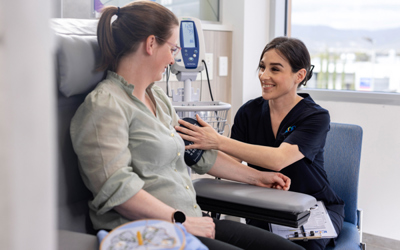What are the treatment options for uterine cancer?
The treatment options for uterine cancer will depend on the type of uterine cancer you have and its stage, as well as your overall health and treatment preferences. Most patients will begin treatment with surgery, and, in many cases, no further treatment is needed. However, follow-up treatments may include radiotherapy, chemotherapy, hormone therapy, immunotherapy or targeted therapies. This page aims to give you a comprehensive overview of how uterine cancer treatment works.
Surgery for uterine cancer
Surgery is commonly performed for people with uterine cancer to remove cancerous tissue, identify the stage of uterine cancer and whether it has spread to the lymph nodes. While surgery is the main treatment for uterine cancer, other treatments may be required following surgery if your cancer is considered high-risk or advanced.
Hysterectomy and bilateral salpingo-oophorectomy
A hysterectomy with bilateral salpingo-oophorectomy refers to the surgical removal of the uterus, both fallopian tubes and both ovaries. For some people with early-stage uterine cancer that is contained within the uterus, the ovaries may not need to be removed.
The three approaches for uterine cancer surgery, performed under general anaesthesia, include:
-
Open hysterectomy or laparotomy
A long incision is made through the skin and abdominal wall or vagina to access your uterus and other internal organs.
-
Laparoscopic hysterectomy
A minimally invasive procedure that uses three to four small incisions to access the uterus. Laparoscopic procedures result in less postoperative pain and complications, shorter hospital stay and faster recovery compared to open hysterectomy.
-
Robotic-assisted hysterectomy
Uses a robotic system to perform laparoscopic hysterectomy remotely, allowing greater precision in comparison to standard laparoscopic surgery.
Radiotherapy for uterine cancer
Women who have radiotherapy for uterine cancer will receive external and, in some cases, internal radiotherapy. Radiotherapy is primarily delivered after surgery to treat advanced uterine cancer or tumours that have been difficult to remove through surgery alone. Occasionally, you may receive radiotherapy ahead of surgery to reduce the size of the tumour.
For women who cannot undergo surgery, radiotherapy is the primary treatment option along with chemotherapy.
External beam radiation therapy
External beam radiotherapy (EBRT) is used to treat uterine cancer by delivering highly targeted radiation therapy beams to the uterus, lymph nodes and other areas where cancerous cells have been detected.
Internal radiation therapy
Internal radiotherapy is also known as brachytherapy. For uterine cancer, a radiation source is placed inside the body in the vaginal vault (the top of the vagina), or inside the uterus if a hysterectomy has not been performed.
Chemotherapy for uterine cancer
Chemotherapy uses a range of drugs to destroy and slow the growth of uterine cancer cells. Chemotherapy treatment is commonly used for high grade uterine cancers that grow and spread quickly, for uterine cancers that have returned after treatment or when surgery is not a treatment option.
Learn more about chemotherapy and how it is delivered.
Chemotherapy treatment takes place over several sessions, known as a cycle. Your care team will walk you through how many cycles you may need for your course of treatment, with most people completing chemotherapy in a period of three to six months.
Common chemotherapy medicines
There are a number of different chemotherapy drugs that are used to treat uterine cancer. These drugs are typically combined based on factors such as the type of uterine cancer you have, your cancer’s stage and how much it has spread. Some of the drugs used include:
-
Carboplatin and paclitaxel
This is a combination of two different chemotherapy drugs that disrupt and slow the growth of cancer cells. They may be delivered after surgery to destroy any remaining cancer cells, or with radiotherapy (chemoradiation) to make the cancer cells more sensitive to radiation. Carboplatin and paclitaxel are also used to treat advanced (metastatic) and recurrent uterine cancer (uterine cancer that has returned after treatment). They are given by intravenous infusion every three to four weeks over several months.
-
Cisplatin
Cisplatin is a drug that is used together with radiotherapy to make the cancer cells more sensitive to radiation. It works by interfering with the DNA of cancer cells so they are unable to divide and grow.
-
Doxorubicin and cisplatin
This combination of chemotherapy drugs is usually given to treat advanced (metastatic) and recurrent uterine cancer. They work by stopping certain processes with a cancer cell’s DNA, preventing cancer cells from dividing and growing. They are usually given by intravenous infusion every three weeks.
Hormone therapy for uterine cancer
Oestrogen is a hormone that feeds uterine cancer cells, causing them to grow and spread. Through the use of hormone therapy drugs, uterine cancer cells are deprived of oestrogen to slow their growth. Hormone therapy is most often used for uterine cancers that are advanced, or uterine cancers that have returned and are considered low grade. It may also be used as an alternative to surgery for women with early stage, low grade uterine cancer.
Hormone therapy drugs which are commonly used in the treatment of uterine cancer include:
Medroxyprogesterone acetate - This is a hormone medication that mimics the naturally occurring progesterone hormone in our bodies by suppressing the stimulating effect of oestrogen on cancer cells in the endometrial lining of the uterus. It is taken orally as a tablet once a day. It can also be given via a hormone-releasing intrauterine device (IUD) which is placed into the uterus by a doctor.
Immunotherapy for uterine cancer
Immunotherapy may be used if your uterine cancer is advanced or has returned. This treatment option uses your own immune system to slow the growth of uterine cancer cells and to destroy existing ones. In Australia, there are no approved immunotherapies for uterine cancer.
Targeted therapies for uterine cancer
Similar to immunotherapy, targeted therapies may be used to treat advanced and high-risk uterine cancers or uterine cancers that have returned. Targeted therapies focus specifically on treating the uterine cancer through targeting cancer cells and not healthy cells. In Australia, there are no approved targeted therapies for uterine cancer.
Clinical trials for uterine cancer
Icon offers a wide-range of clinical trials providing patients with access to new and evolving treatments. Clinical trials offer hope and opportunity and contribute to breakthroughs in treatment for future cancer patients.

Treatment by stage of uterine cancer
When you are diagnosed with uterine cancer, your oncologist will develop your treatment plan as part of a multidisciplinary team based on the stage of your cancer and whether you would like to remain fertile after treatment.
Common treatment options for each stage of uterine cancer include:
Stage I uterine cancer
When uterine cancer is classified as stage I, there are treatment options available to help maintain your fertility. Rather than undergoing surgery which can impact fertility, in some cases hormone therapy using progestin may be used instead. However, this type of treatment may only shrink or temporarily cure uterine cancer to give you the chance to get pregnant. It is common for uterine cancer to return following this type of treatment. If maintaining fertility is not a concern for you, your treatment plan will likely start with a hysterectomy and bilateral salpingo-oophorectomy (removal of the uterus, fallopian tubes and both ovaries). In many cases, surgery is the only treatment needed for stage I uterine cancer. Surgery may be followed by chemotherapy and radiotherapy to prevent the cancer cells from coming back.
Stage II uterine cancer
Similar to stage I uterine cancer treatment, stage II uterine cancer is typically treated with a radical hysterectomy and bilateral salpingo-oophorectomy. Pelvic and para-aortic lymph nodes may also be removed as well to identify whether the cancer has spread. Following surgery, it is common for both internal and external radiotherapy to be given.
Stage III uterine cancer
Stage III uterine cancer is typically treated with surgery to remove the uterus, fallopian tubes and both ovaries, alongside debulking surgery (removal of any remaining cancer in surrounding tissues). You may receive radiotherapy first to help shrink your tumour before surgery.
Stage IV uterine cancer
As with earlier stages of uterine cancer, stage IV uterine cancer is often treated with surgery, followed by radiotherapy and chemotherapy. In some cases, hormone therapy, immunotherapy or targeted therapies may be used to destroy or slow the growth of uterine cancer cells.
Surgery, however, may not always be possible if the disease has spread into other organs. Chemotherapy will be the mainstay of treatment in this instance.











